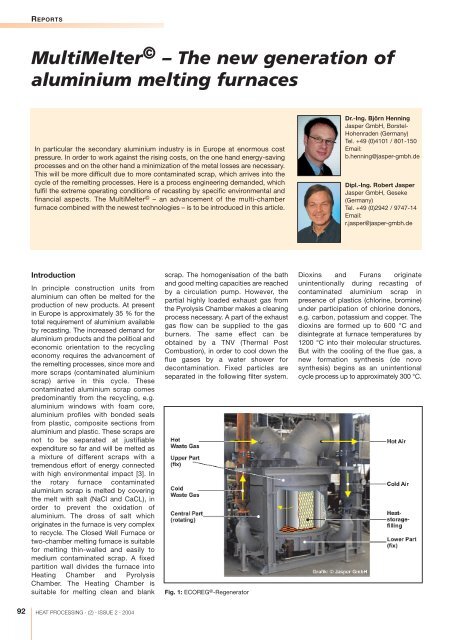The new generation of aluminium melting furnaces - Jasper GmbH
The new generation of aluminium melting furnaces - Jasper GmbH
The new generation of aluminium melting furnaces - Jasper GmbH
Create successful ePaper yourself
Turn your PDF publications into a flip-book with our unique Google optimized e-Paper software.
92<br />
REPORTS<br />
MultiMelter © – <strong>The</strong> <strong>new</strong> <strong>generation</strong> <strong>of</strong><br />
<strong>aluminium</strong> <strong>melting</strong> <strong>furnaces</strong><br />
In particular the secondary <strong>aluminium</strong> industry is in Europe at enormous cost<br />
pressure. In order to work against the rising costs, on the one hand energy-saving<br />
processes and on the other hand a minimization <strong>of</strong> the metal losses are necessary.<br />
This will be more difficult due to more contaminated scrap, which arrives into the<br />
cycle <strong>of</strong> the re<strong>melting</strong> processes. Here is a process engineering demanded, which<br />
fulfil the extreme operating conditions <strong>of</strong> recasting by specific environmental and<br />
financial aspects. <strong>The</strong> MultiMelter © – an advancement <strong>of</strong> the multi-chamber<br />
furnace combined with the <strong>new</strong>est technologies – is to be introduced in this article.<br />
Introduction<br />
In principle construction units from<br />
<strong>aluminium</strong> can <strong>of</strong>ten be melted for the<br />
production <strong>of</strong> <strong>new</strong> products. At present<br />
in Europe is approximately 35 % for the<br />
total requirement <strong>of</strong> <strong>aluminium</strong> available<br />
by recasting. <strong>The</strong> increased demand for<br />
<strong>aluminium</strong> products and the political and<br />
economic orientation to the recycling<br />
economy requires the advancement <strong>of</strong><br />
the re<strong>melting</strong> processes, since more and<br />
more scraps (contaminated <strong>aluminium</strong><br />
scrap) arrive in this cycle. <strong>The</strong>se<br />
contaminated <strong>aluminium</strong> scrap comes<br />
predominantly from the recycling, e.g.<br />
<strong>aluminium</strong> windows with foam core,<br />
<strong>aluminium</strong> pr<strong>of</strong>iles with bonded seals<br />
from plastic, composite sections from<br />
<strong>aluminium</strong> and plastic. <strong>The</strong>se scraps are<br />
not to be separated at justifiable<br />
expenditure so far and will be melted as<br />
a mixture <strong>of</strong> different scraps with a<br />
tremendous effort <strong>of</strong> energy connected<br />
with high environmental impact [3]. In<br />
the rotary furnace contaminated<br />
<strong>aluminium</strong> scrap is melted by covering<br />
the melt with salt (NaCl and CaCL), in<br />
order to prevent the oxidation <strong>of</strong><br />
<strong>aluminium</strong>. <strong>The</strong> dross <strong>of</strong> salt which<br />
originates in the furnace is very complex<br />
to recycle. <strong>The</strong> Closed Well Furnace or<br />
two-chamber <strong>melting</strong> furnace is suitable<br />
for <strong>melting</strong> thin-walled and easily to<br />
medium contaminated scrap. A fixed<br />
partition wall divides the furnace into<br />
Heating Chamber and Pyrolysis<br />
Chamber. <strong>The</strong> Heating Chamber is<br />
suitable for <strong>melting</strong> clean and blank<br />
HEAT PROCESSING · (2) · ISSUE 2 · 2004<br />
scrap. <strong>The</strong> homogenisation <strong>of</strong> the bath<br />
and good <strong>melting</strong> capacities are reached<br />
by a circulation pump. However, the<br />
partial highly loaded exhaust gas from<br />
the Pyrolysis Chamber makes a cleaning<br />
process necessary. A part <strong>of</strong> the exhaust<br />
gas flow can be supplied to the gas<br />
burners. <strong>The</strong> same effect can be<br />
obtained by a TNV (<strong>The</strong>rmal Post<br />
Combustion), in order to cool down the<br />
flue gases by a water shower for<br />
decontamination. Fixed particles are<br />
separated in the following filter system.<br />
Fig. 1: ECOREG ®-Regenerator<br />
Dr.-Ing. Björn Henning<br />
<strong>Jasper</strong> <strong>GmbH</strong>, Borstel-<br />
Hohenraden (Germany)<br />
Tel. +49 (0)4101 / 801-150<br />
Email:<br />
b.henning@jasper-gmbh.de<br />
Dipl.-Ing. Robert <strong>Jasper</strong><br />
<strong>Jasper</strong> <strong>GmbH</strong>, Geseke<br />
(Germany)<br />
Tel. +49 (0)2942 / 9747-14<br />
Email:<br />
r.jasper@jasper-gmbh.de<br />
Dioxins and Furans originate<br />
unintentionally during recasting <strong>of</strong><br />
contaminated <strong>aluminium</strong> scrap in<br />
presence <strong>of</strong> plastics (chlorine, bromine)<br />
under participation <strong>of</strong> chlorine donors,<br />
e.g. carbon, potassium and copper. <strong>The</strong><br />
dioxins are formed up to 600 °C and<br />
disintegrate at furnace temperatures by<br />
1200 °C into their molecular structures.<br />
But with the cooling <strong>of</strong> the flue gas, a<br />
<strong>new</strong> formation synthesis (de novo<br />
synthesis) begins as an unintentional<br />
cycle process up to approximately 300 °C.


